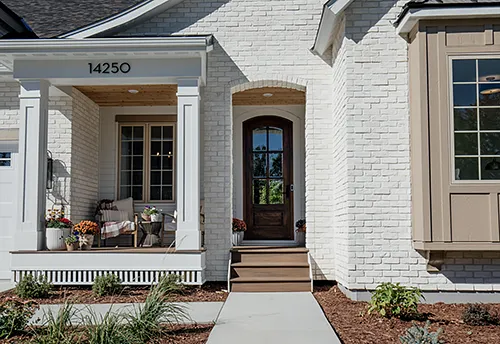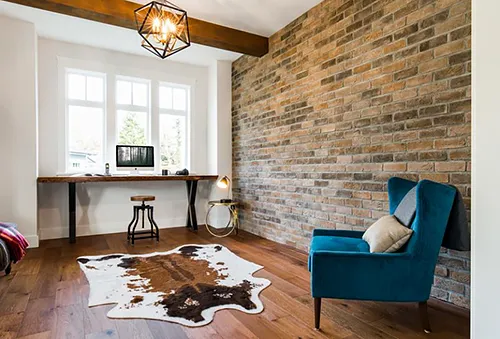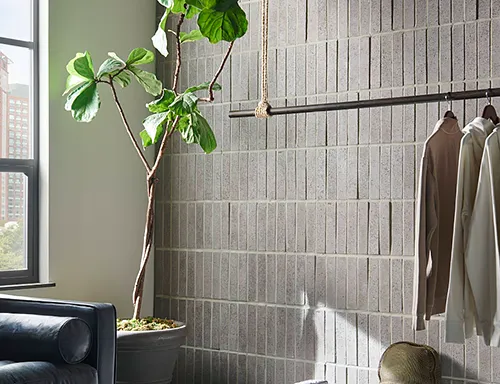Designing with Brick All Around the House
by Rachel Lyon, Editorial Director for Direct from the Designers
It may have had its heyday in the past before modern building materials came onto the scene, but brick is still a component of many new homes. Why? People love the historical element, range of colors, and visual effect of a repeating pattern. Something about brick makes it an asset across the board, and you’ll see designers and homeowners drawn to it, whether that means preserving brick elements in a renovation or planning to incorporate it into a brand-new design. If you’d like to add the universal appeal of brick to your home, here are some ideas!

Exterior Brick
Most brick you see in cities and on antique homes has been there a while—it could be centuries old! Brick stood out above other building materials of the time thanks to its longevity and relatively easy mass production and installation. A number of brick kilns cropped up across colonial America to serve the demand, and some local authorities even mandated brick in building codes to reduce fire risk. Wood construction was too much of a liability to remain favored as urban areas developed, so brick became ubiquitous.
All this means that brick exteriors project a solid and steadfast feel, so look no further if that’s what you want for your home. Certain architectural styles call for this—think colonial and Federal—but it also works well for a variety of traditional and luxury designs. Just make sure to consider the effect of color! While red brick definitely has its place in history, it may look incongruous on a standalone house. Brown brick makes a wonderful choice for homes with a natural backdrop, tan matches desert locations well, and white is perfect for many neighborhoods where light tones are preferred. With all these options, you may find a great complement for a home you never imagined finishing in brick before!
If a whole exterior or façade of brick comes off too strong, rest assured it works well with other types of siding. Many cottage, Craftsman, and farmhouse designs are made to use varied materials to show off their different shapes and architectural highlights. So, brick could fit in well around the foundation or under a gable or two—it all depends on what you have to work with! Don’t be afraid to ask for a professional opinion to ensure you love the final results.

Interior Brick
There are all sorts of ways to incorporate brick inside the house, too. Given its fireproof nature, the most common place to find brick is still in and around fireplaces. Hearth areas are focal points that draw attention on their own, but you can tailor that effect with different finishes. Stone has a more rustic vibe while marble surrounds provide a polished look, for example. When it comes to brick, you can opt for an old-fashioned finish with red or brown or a modern industrial appearance with shades of grey.
In rooms that don’t already have an obvious focal point to compete with, brick makes a wonderful accent. You can break up monotony anywhere with an accent wall! Many homeowners use brick on just one wall for interest, but you can also give an enclosed space a completely different ambiance than the rest of the house with brick on all sides. Make sure to consider all the options! Highlighting one of the side walls is popular—it’s a good idea to choose the side that gets more natural light—but brick also helps windows pop, so you may prefer an exterior wall instead. You can also add a neat pattern to the kitchen backsplash, around cased entries in living areas, or beside a staircase. You’ll find tons of inspiration images online, so see what catches your eye!

Unique Brick Patterns
Don’t be afraid to think outside the box—brick may seem simple at first, but it can be installed in all sorts of patterns called bonds. To start, the long sides are called stretchers and the short sides are called headers, and they can be laid in dozens of patterns to create different joints across the wall. Some are load-bearing while others are purely decorative, but these days, brick is typically used for aesthetic versus structural reasons, so most people don’t have to worry about that and can choose whatever suits them. Whether you’re drawn to a traditional stretcher, common, Dutch, or Flemish bond, the stark modern order of a stack bond, or you’d like to come up with your own unique look, brick will add plenty of interest to your design.
If you’d like to use brick on or in your home, take a look at the beautiful brick veneers available from Cultured Stone! They have traditional options that look plucked from colonial times as well as wonderful complements for chic modern designs. No matter which profile you prefer, there are different color blends to help strike the right tone for your aesthetic vision. Find a local dealer and start discussing the possibilities today!
BROWSE HOME PRODUCT ARTICLES
- Creating a Spa-Like Master Bathroom »
- Designing a Water-Efficient Bathroom »
- Design a Modern Bathroom »
- View All Bathroom Articles »
- Building a New Home »
- Building a Duplex »
- Finding the Right Home Builder »
- View All Building Tips Articles »
- Adding the Right Columns»
- Decorative Touches for Your Interior»
- Shutters for Every Architectural Style »
- View All Columns & Millwork Articles »
- How to Use Specialty Laminates »
- Decorative Touches for Your Home's Interior
- View All Countertops and Surfaces Articles »
- What Goes Into a Great Deck? »
- Decorative Touches for Your Home's Interior »
- View All Decking Articles »
- Choosing Glass for Your Entry »
- Stylish Personas for Your Front Door »
- Using Sidelites and Transoms »
- View All Door Articles »
- Choose Siding for Your Region »
- Get the Most Out of Exterior Paint »
- Mixing Siding to Define Your Exterior »
- View All Exterior Articles »
- Finding the Right Home Builder »
- The Appeal of Small House Plans »
- Choosing the Perfect Floor Plan »
- View All Finding a Home Plan Articles »
- Colorful Flooring for Your Home »
- Designing With Different Widths»
- Chic, Neutral, Gray Flooring »
- View All Flooring Articles »
- Garage Doors That Add Curb Appeal »
- Caring for Your Garage Doors »
- Benefits of Insulated Garage Doors »
- View All Garage Door Articles »
- Reclaimed Products for Your Home »
- Building a Green and Stylish Home »
- Benefits of Building with SIPS »
- View All Green Building Articles »
- Cool Gadgets for Your New Home »
- Creating a Hi-Tech Home »
- Efficient Gifts for New Homeowners »
- View All Home Electronics Articles »
- Improve Your Home's Air Circulation »
- How to Improve the Air Circulation in Your Home »
- View All HVAC Articles »
- Bedrooms Designed for Sleep »
- Selecting a Fireplace for Your Home »
- Crafting a Luxurious Master Suite »
- View All Interior Design Articles »
- Design the Perfect Outdoor Space »
- Dive into a Beautiful Pool »
- Design a Sizzling Outdoor Kitchen »
- View All Outdoor Living Articles »
- Apps to Help You Pick Paint Colors »
- Create the Perfect Mood with Paint »
- How to Read the Color Wheel »
- View All Painting & Decorating Articles»
- Creating a Spa-Like Master Bathroom »
- High-Impact Kitchen Upgrades »
- Creating a Water Efficient Bathroom »
- View All Plumbing Fixtures Articles»
- Cladding That Complements Your Exterior »
- Reasons to Consider Prefinished Siding »
- View All Siding & Cladding Articles»
- All About Solar Powered Skylights »
- Natural Lighting for the Dark Corners of Your Home »
- Design a Better Bedroom with Skylights »
- View All Skylight Articles»
.png)
.png)
